
Key Takeaways
- The best PR responses to a crisis occur within 24- to 48-hours after the initial media firestorm.
- Product issues can generate the worst PR crises in the short-term. A failing product can generate 135x more negative coverage for a brand than during an average day.
- Data breaches and governance crises have the biggest long-term impact on reputation. Companies with those crises had the most negative media sentiment six months later.
- Social and political crises have relatively minor long term impacts. Stakeholders may ultimately judge companies on their commitment to core business goals over their social and political values.
PR crises can swiftly impact a company’s reputation and bottom line. Some crises can shed up to half of a company’s stock price for over 2 years.
Yet few companies are adequately equipped to respond to a crisis. It’s vital for PR teams to build concrete plans ahead of time, so what should they consider when building crisis communications plans?
A good crisis response first requires understanding the types of crises and how they unfold. While crises have similarities, they’re not all created equal. The media treats news around a product failure differently than a DE&I controversy, for example. Communicators need to be ready to respond to different crises differently.
What is a PR Crisis?
A PR crisis is an event that harms an organization’s reputation, credibility, or operations. In these moments, negative media coverage reaches new highs. PR teams often drop everything to focus on the problem.
PublicRelay reviewed 100+ crises across nearly 40 companies spanning over 10 industries. Pulling this data together gives insight into how a crisis could play out during the initial shock period of media reporting.
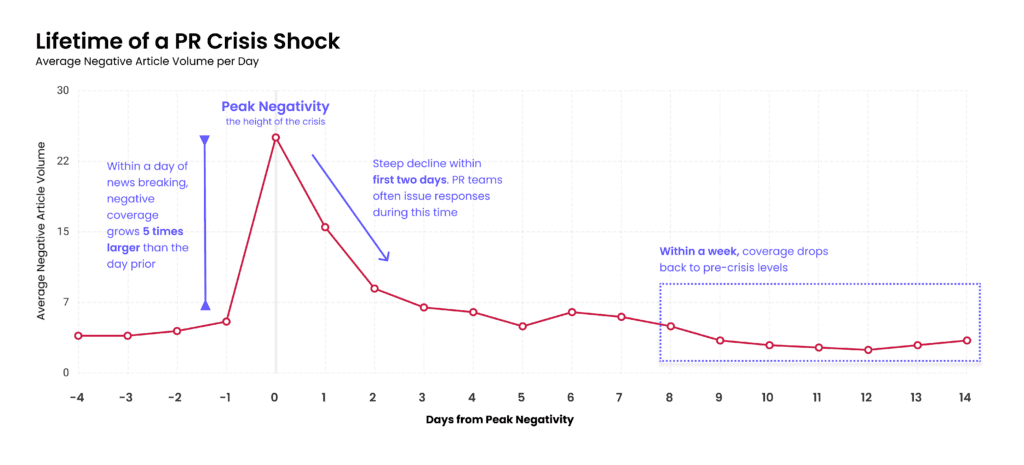
These crisis shocks have little warning. On average, crisis chatter grows rapidly in just a day to reach peak negativity, or when the media firestorm reaches its highest point.
On one hand, crisis shocks are generally short-lived. Negative coverage usually returns to pre-crisis levels in little over a week following a rapid decline within the first two days.
On the other hand, there is very little time to respond. The news cycle may move on after a few days, but public opinion cements quickly and can generate lasting reputational damage.
We found that the best PR responses occur within 24 to 48 hours after peak negativity. This window is when counter-messaging is most effective and communicators can mitigate the long-term reputational damage caused by the crisis.
What are the different types of crises?
Understanding how crises are different can also help predict how bad they will be. We grouped crises into three broad categories:
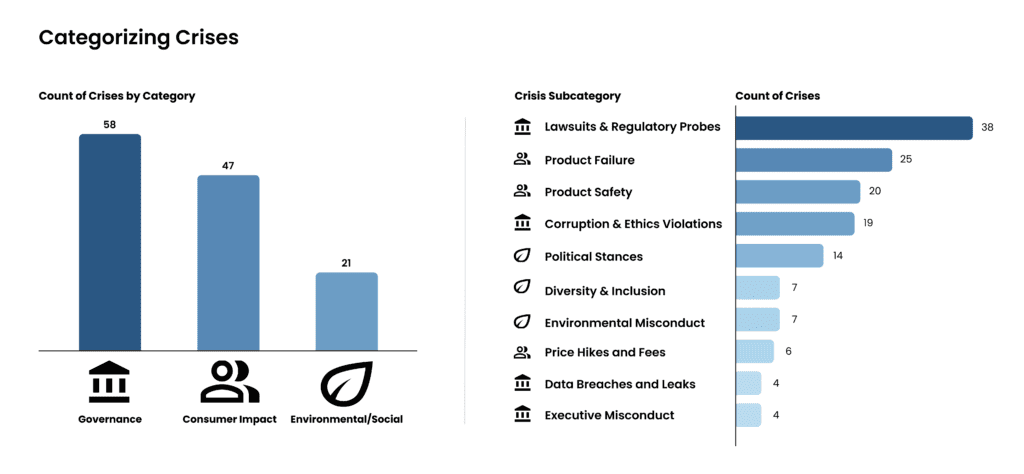
- Governance Crises: Triggered by lawsuits and regulatory investigations, these occur most often in the corporate landscape. Examples include misleading product claims, blocked mergers, and product safety lawsuits. They call into question a brand’s corporate integrity and compliance.
- Consumer Impact Crises: Issues like product failures, safety concerns, and price hikes fuel this type of crisis. They drive a customer’s experience with a brand. As a result, they generate headlines in mainstream media. Common examples include prolonged service outages and product recalls.
- Environmental and Social Crises: These crises are tied to a company’s socio-political standing. Examples include backlash over diversity issues and ecological damage. Crises like these often drive social media buzz and potential boycotts.
In the short-term: How bad is bad?
In the moment, some crises can be worse than others. To compare how bad crises are as they’re happening, we analyzed their peak negativity. We examined how bad the most negative day of a brand crisis was by comparing it to the brand’s negativity during an average day.
Crises like Product Failures and Safety lead to the most negativity. A failing product can generate 135x more negative coverage for a brand than during an average day. Product stories impact everyday news readers, so they quickly catch the attention of mainstream outlets.
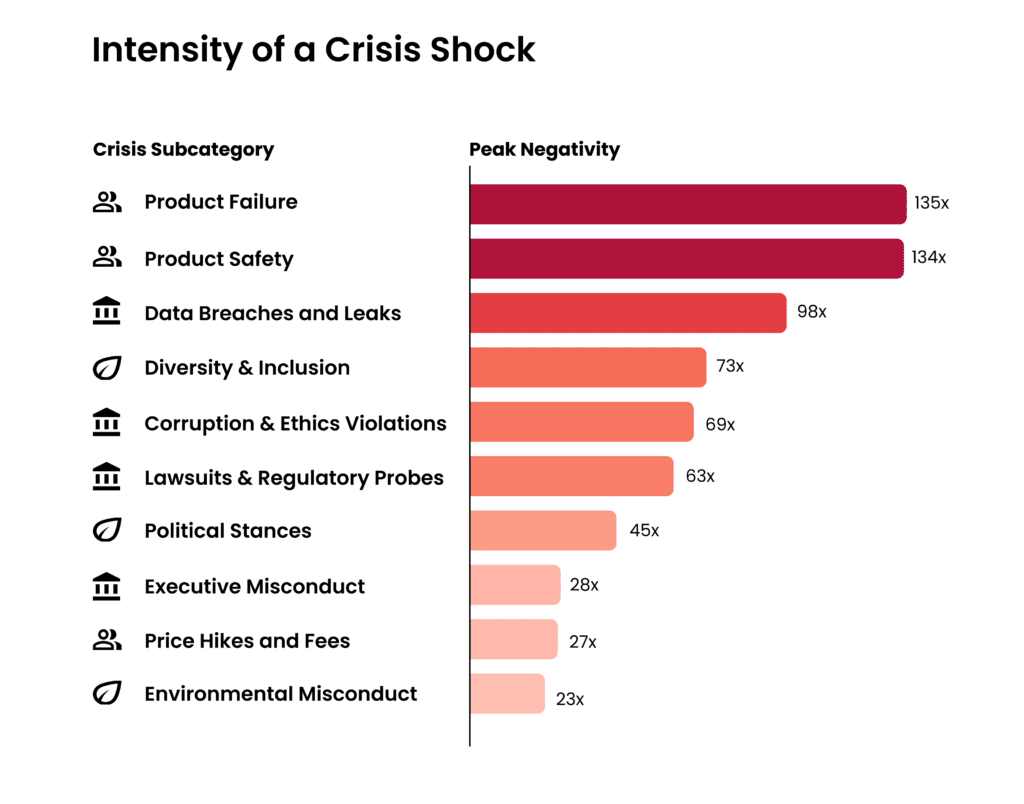
In contrast, issues like Executive Behavior and Environmental Misconduct only receive 20-30x more negative coverage than during a brand’s average day. Those crises are serious, but they may generate less news. Their impact on the public may be hazy and the media pickup can be limited to niche trade publications.
In the long-term: How will it affect my reputation?
Once the initial shock dissipates, the PR work isn’t over. Even when the media cycle moves on, the effects of a crisis can linger for months or years.
To understand the long-term effects of crises on brand reputation, we compared the average media tone of each brand six months before and after a crisis.
The results showed that some crises are easier to recover from others. Data Breaches stand out for their enduring negative impact on reputation. Companies with data breaches had the most negative media sentiment six months later. Leaks from hacks can generate panic and concern among key stakeholders. Data breaches also attract lawsuits and regulatory responses which draw out their lifespan.
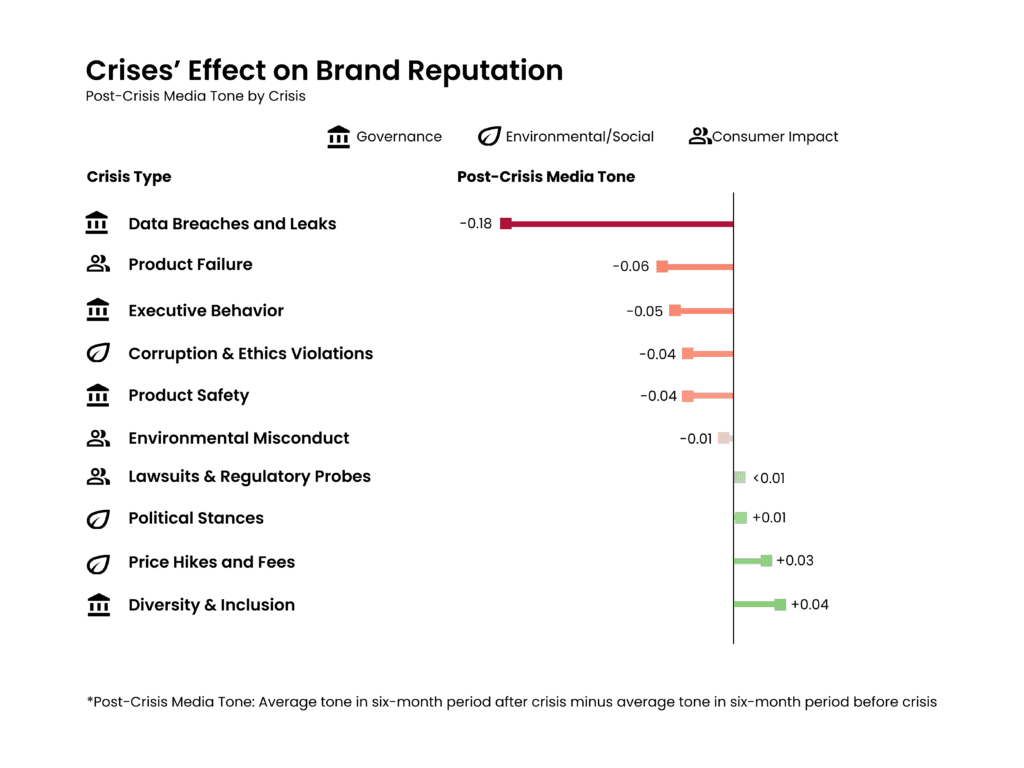
Similarly, governance crises that erode shareholder trust can have lasting repercussions on a company’s reputation. Executive Misconduct, for example, had a persisting negative impact. This was despite those crises seeing less coverage when they first occurred.
Notably, social and political crises are easier to recover from. Backlash to a company’s Political Stances or Diversity & Inclusion initiatives did not often generate long-term negative reputational impacts. Stakeholders may ultimately judge companies on their commitment to core business goals over their social and political values.
Understand the crisis to plan your response
Becoming familiar with the different types of PR crises is critical. Not every crisis is the same, and they each have different short-term or long-term effects.
Consider the types of PR crises that can affect your brand and examine their characteristics. Doing so can help you plan your response strategy and resourcing needs for each different type of PR crisis.
To learn more about our research on PR crises, contact us here.
Related Resources


Key Takeaways
- For a tailored outreach strategy, communicators working with female CEOs should target highly syndicated outlets to help close the media visibility gender gap.
- Measurement approaches should take gender into account and consider female CEOs’ reputation impact, not just their media volumes.
In our analysis of CEO media representation, we found a significant gender disparity. While female CEOs lead 16% of companies in PublicRelay’s Benchmark dataset, they receive disproportionately less media attention compared to their male counterparts. Females account for only 5% of CEO mentions and quotes in news articles.


Social Media Amplifies Gender Disparity
This gender bias extends to social media users, where articles featuring female CEOs receive far fewer shares than those featuring male CEOs. On average, articles mentioning female CEOs are shared 42% less often than articles mentioning male CEOs. Similarly, on average, articles quoting female CEOs are shared 60% less often than articles quoting male CEOs.
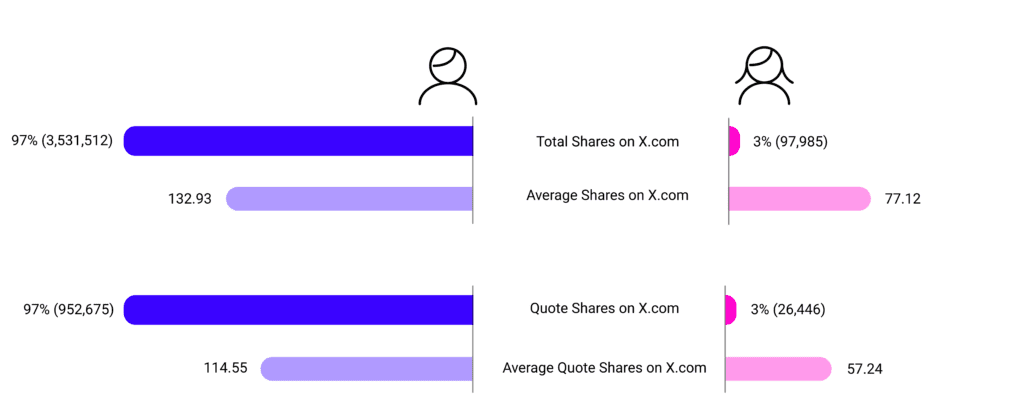

Syndication Can Help Close the Gap
Syndication data is slightly less bleak. Female CEOs account for 5% of syndicated CEO mentions and 7% of syndicated articles featuring CEO quotes. In addition, the average syndication count for female CEO mentions and quotes is slightly higher than for their male counterparts.
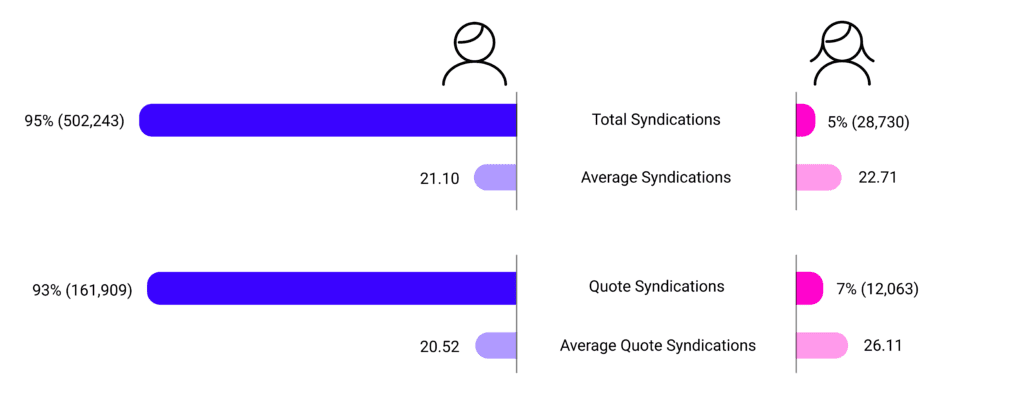

Female CEOs Win on Sentiment
There is also a silver lining for female CEOs in media sentiment. Articles and quotes featuring female CEOs tend to have a more positive tone compared to those featuring male CEOs. This indicates a more favorable portrayal of female CEOs in the media.
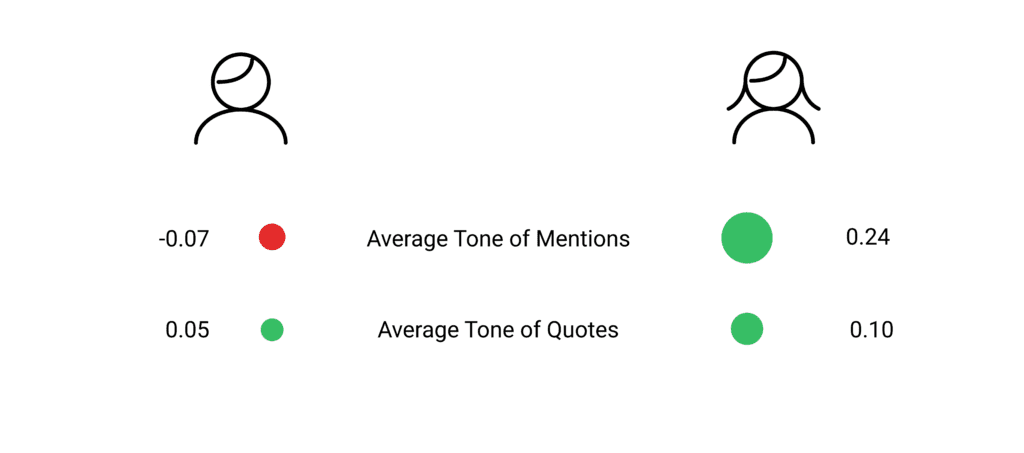

Female CEOs Positively Impact Company Reputation
While male CEOs may have a slightly more positive personal brand, as measured by the ‘Perception Score’ element of PublicRelay’s CEO Index, female CEOs significantly outshine them in their impact on company reputation.
On average, female CEOs have a positive impact on their company’s reputation, with an ‘Impact Score’ of 2.2, whereas male CEOs’ impact on the brands they represent is actually negative on average, with a score of -0.74.
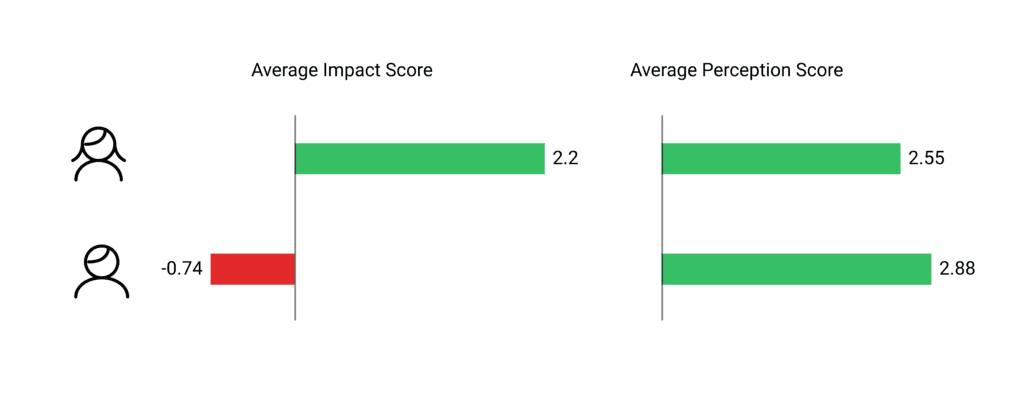

Diversity is Opportunity
The data highlights the persistent gender gap in CEO media representation and visibility. However, the positive media sentiment and impactful reputation of female CEOs compared to male CEOs underscore how important it is for brands to elevate diverse voices in corporate leadership.
Related Resources


The electric vehicle (EV) race is speeding along, fueled by automakers jockeying for consumers’ minds and wallets. As legacy car companies build their EV reputation, are their news headlines driving EV sales?
To answer this question, PublicRelay compared over a year’s worth of EV media coverage and sales from leading automakers. Here’s what we found:
Legacy car companies are ahead in consumers’ minds
Despite their late entrance to the EV race, legacy car companies have been punching above their weight on EV communications. Over the past year, legacy automakers’ positive share-of-voice on EVs has outpaced their EV market share.
That’s a communications win for legacy car companies, especially for GM and Ford. Those two automakers have branded themselves as leading EV players. GM CEO Mary Barra has vowed to close the EV sales gap with Tesla in 2025 and pledged to end sales of gas-powered cars by 2035. Ford CEO Jim Farley has publicly committed over $50 billion in EV investments alongside partnerships with Chinese and Korean battery firms.


The automakers’ PR strategies are borne out in PublicRelay’s analysis of the EV media landscape, featuring brands like Tesla, GM, Ford, Toyota, and Volkswagen. GM and Ford each maintain around 20% of the industry’s EV’s share-of-voice despite each having approximately 7% of the US’s EV market share. Even Volkswagen and Toyota have share-of-voices that exceed their shares of the market.
EV media wins are leading to market share gains
An outsized share-of-voice likely indicates future market share growth in EVs. Advertising firms like Nielsen have long highlighted the value of investing in media share-of-voice early to generate business growth later. That’s especially true when budgets are tight. Companies who build reputational strength early reap the rewards faster when market conditions mature.
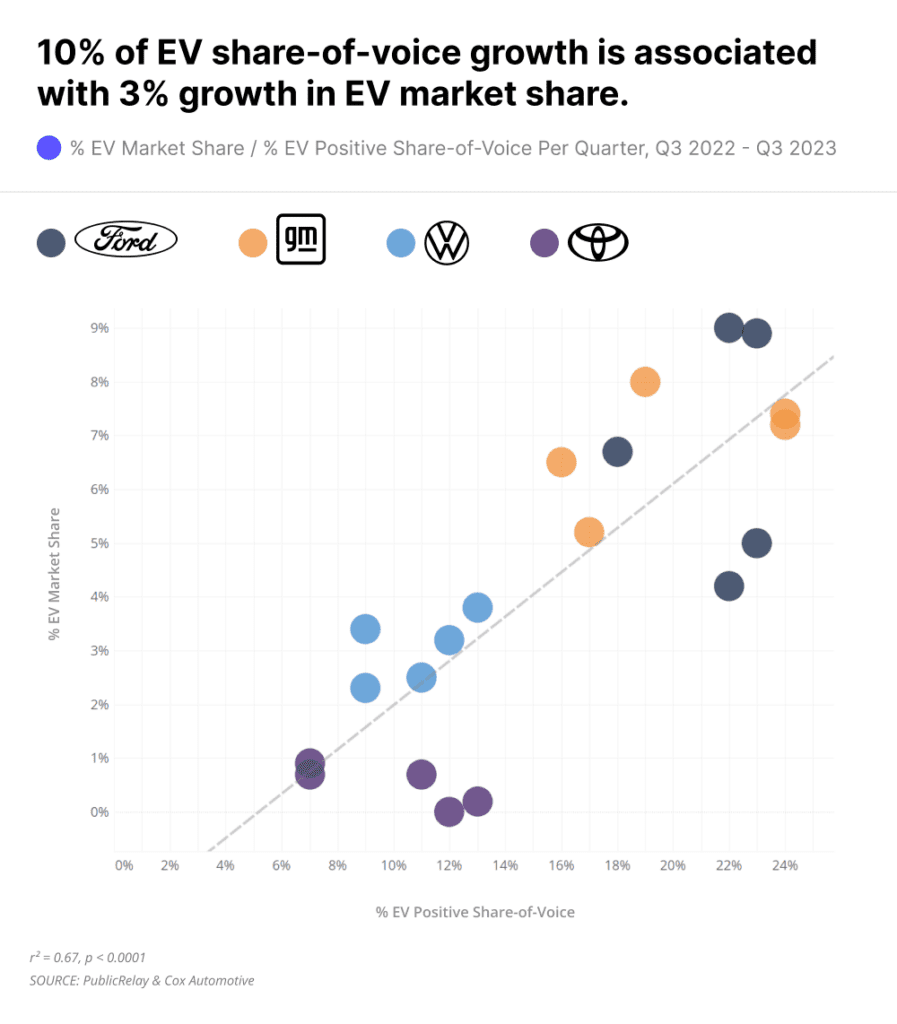

That trend is already holding true for legacy automakers in the EV space. 10% more positive EV share-of-voice is generally associated with 3% growth in EV market share, quarter over quarter.
Tesla is losing market share, but it’s media share-of-voice is rebounding
Tesla’s trajectory is also consistent with this trend. Elon Musk’s company is the clear EV market leader. But unlike legacy automakers, Tesla’s PR efforts have significantly lagged its market power. At the end of 2022, Tesla’s share-of-voice was less than half its market share.
Combined with growing competition in the EV space, Tesla’s reputation deficit has predictably led to a decrease in its market share. Tesla’s share of the EV market has decreased from 64% to 50% in the past year.
Numerous controversies surrounding Elon Musk’s takeover of Twitter have alienated potential Tesla customers. Tesla also faces ongoing product reliability issues. Without sufficient reputational capital in place, EV buyers may be more willing to look beyond Tesla towards other brands.
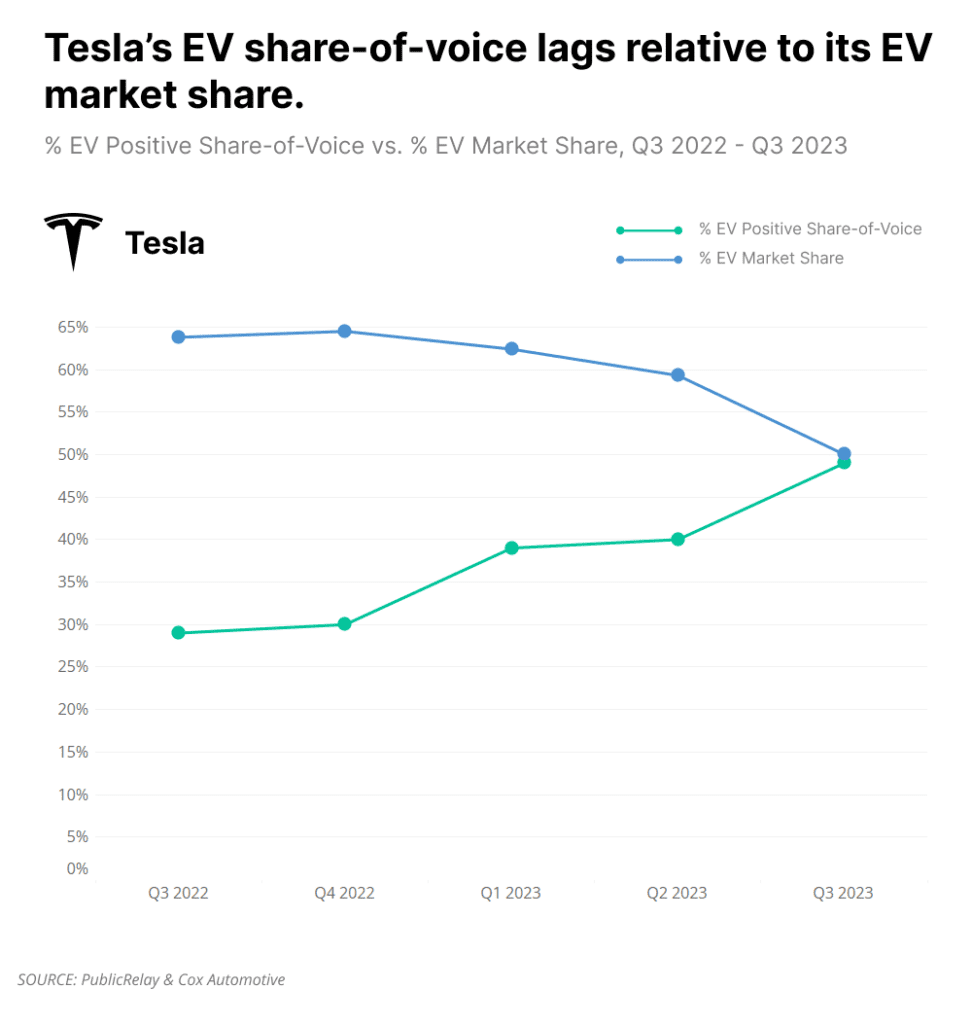

Tesla is far from doomed, however. The company has been rapidly increasing its EV share-of-voice in 2023. Its market leader status has enabled it to capture headlines about lowering prices and the launch of the Cybertruck. The brand has been quick to point out its insulation from chip supply constraints and UAW strikes affecting Ford and GM.
The road ahead
At the same time, legacy automakers have begun to pull back from their bold EV stances amid high interest rates, fears about inadequate EV charging infrastructure, and a surge in hybrid vehicle sales. The result has been a decline in share-of-voice among legacy car companies at the end of 2023.
Whether or not legacy automakers renew their focus on their EV businesses through 2024 remains to be seen. If they do, building their EV share-of-voice will be a necessary place to start.
Related Resources


As companies and shareholders increasingly prioritize diversity and inclusion efforts, many are turning to diversity audits to evaluate their progress.
However, our recent research suggests that these audits may not have the positive media impact that communicators might hope for.
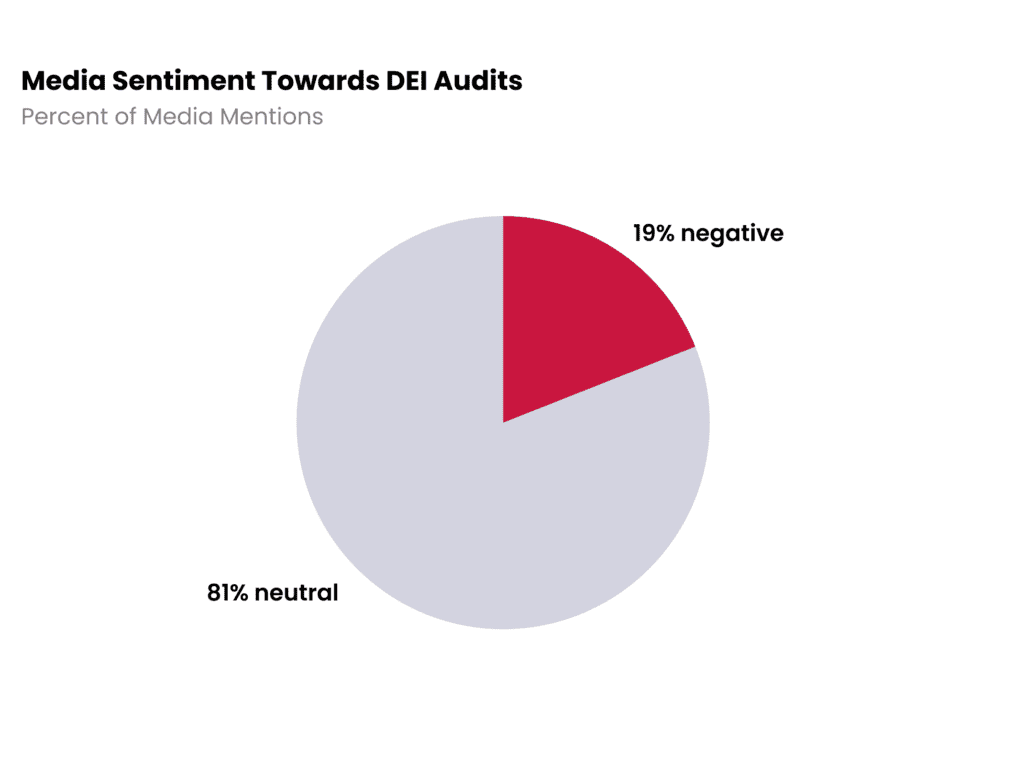

Independent reviews of diversity and inclusion efforts have led to zero media reputation gains for the companies we track in our media Benchmark. In fact, controversy and skepticism surrounding the process of conducting such audits has meant coverage is neutral at best, and sometimes even negative.
The main contributor to negative sentiment was coverage of how the decision to conduct an audit was reached. Voluntary diversity audits were often framed as a reluctant reaction to pressure from shareholders, with plenty of commentary around companies’ initial pushback to the idea. Also, coverage often mentioned existing allegations of discrimination to explain shareholder demands for audits. This context undercut the potential reputational gains for diversity audit stories.
Another reason for the lukewarm coverage is that the auditing process is vulnerable to being portrayed as performative or insufficient. For example, the qualifications or independence of external auditors were often questioned in media coverage. Alternatively, if a company conducted an internal audit, media coverage suggested that the audit was biased or lacking in transparency. Issues related to the sufficiency, independence and transparency of audits together accounted for 24% of negative messages.
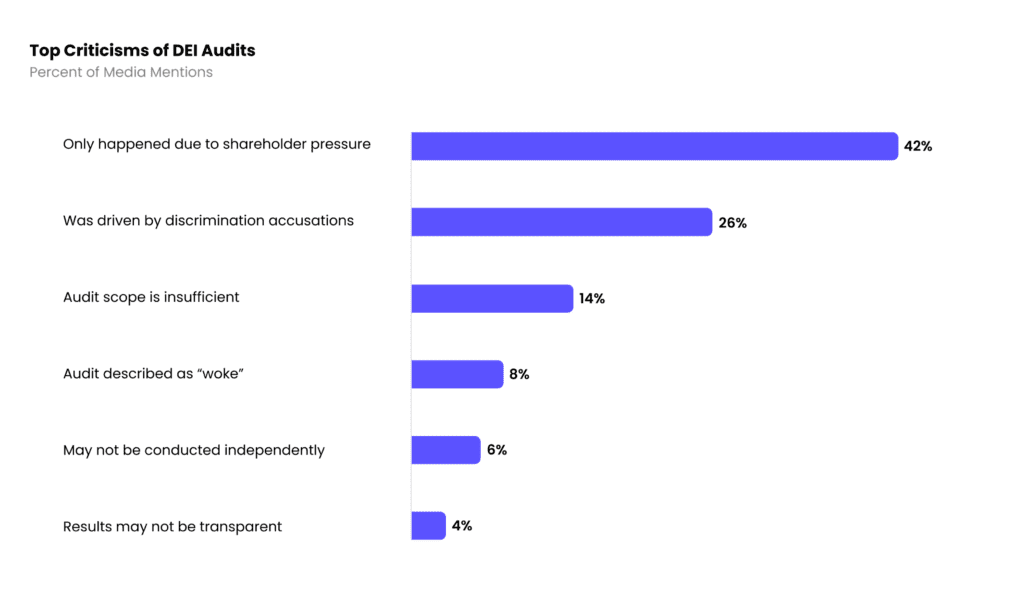

The recent politicization of corporate DEI initiatives also plays a role. The media will publish the ‘anti-woke’ rhetoric of shareholders who take issue with companies choosing to perform a diversity audit. This results in unwanted controversy – whether the articles in question are written in support of such views or not.
When diversity audits materialize, communicators should be prepared for the media to broadcast shareholder views. Whether these shareholders are for or against diversity audits, their comments are likely to be critical of the company, undermining any potential reputational gains.
In theory, showcasing the progress of diversity audits should be a great PR tool to demonstrate action and commitment to an important issue. However, in practice, results are neutral at best. While the media continues to frame these stories from the viewpoint of critical shareholders, communicators should minimize proactive messaging about audits, and look elsewhere for stories that can more effectively communicate their brands’ DEI values.
Related Resources


It appears that ESG is retreating from business. Support for ESG-related corporate shareholder resolutions is declining. Finance firms like BlackRock and Vanguard have walked back some of their ESG initiatives in the face of conservative scrutiny.
Do these developments signal the end of ESG? The stakes are high for communicators, who will be responsible for sharing – or downplaying – their organization’s values and initiatives with the marketplace.
PublicRelay sought to answer this question by examining over a year’s worth of ESG media coverage across seven sectors. Here’s what we found:
ESG as a concept is on the decline
ESG as an overall concept is becoming a smaller part of the news cycle. Corporate news is increasing around 5% quarter over quarter. But stories mentioning ESG as a singular entity are decreasing 7% each quarter.
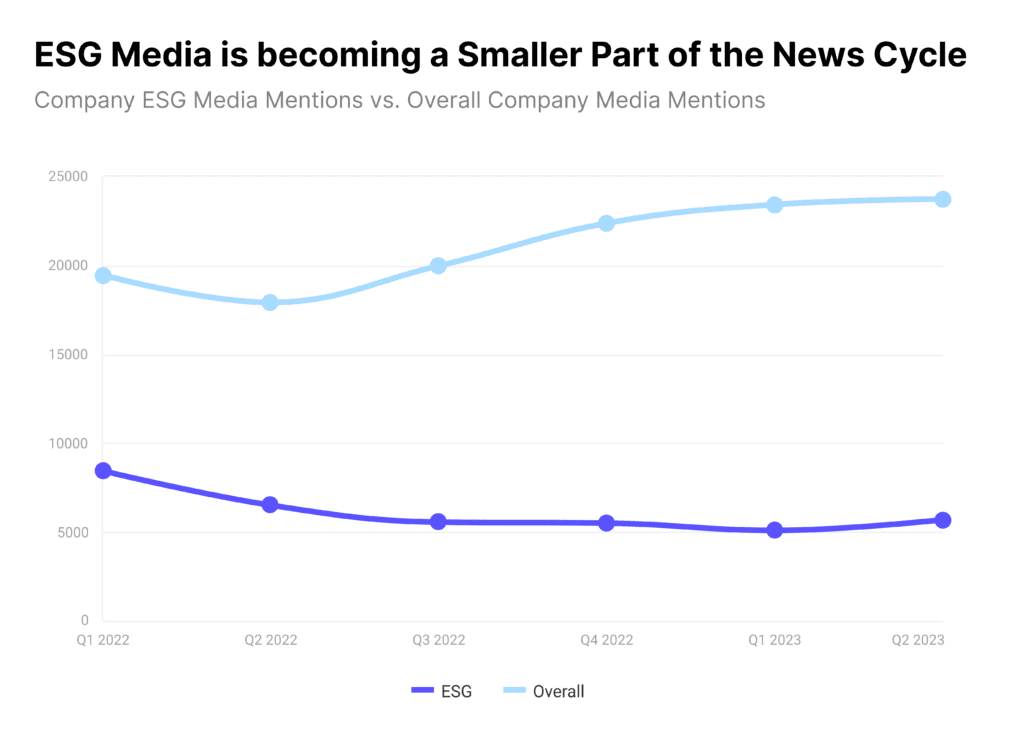

Corporate governance is maintaining its importance amid economic uncertainty
That doesn’t mean that the attributes that make up ESG are becoming any less important. Furthermore, not all components of E, S, and G are performing equally. Much of the decrease in ESG stories is attributed to the decline in social topics. That includes themes like inclusivity and community impact.
But governance stories have maintained their lead in the ESG media mix. They’re even increasing in 2023. This is in large part due to growing economic uncertainty. As the news cycle focuses on business performance, issues like corporate ethics, overhead, and board decisions are in the spotlight.
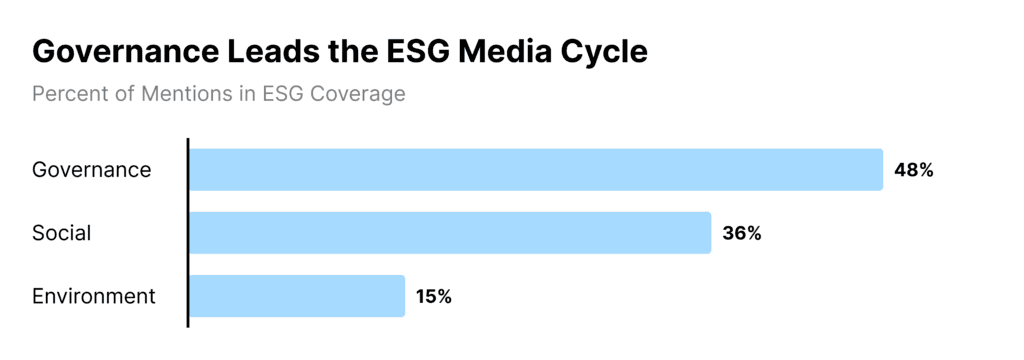

Environmental stories are rare but can pose risks for several sectors
Stories about company environmental initiatives are rare compared to those about corporate governance. Environment mentions tend to be 15-20% of overall corporate ESG coverage, quarter over quarter.
But companies’ impact on the environment shouldn’t be ignored. The energy sector is receiving backlash to their doubling down on fossil fuel investments. Finance firms face criticism from climate advocates for walking back sustainable investing pledges. In the future, the energy required to power new AI technologies could put Big Tech in the crosshairs of the environment media discussion.
A healthy workplace will matter for business competitiveness
Promoting an engaged and inclusive workplace is still paramount, even with the decline in news about social-related topics. 2023 saw companies face layoffs, return-to-office policies, demands from organized labor, and a new wave of AI tools that may affect the future of work.
Navigating these challenges will require precise communications strategies, both internally and externally. Retaining top talent may have added significance in a news cycle focused on business performance.
ESG isn’t dead, but it’s branding might be
The environmental, social, and governance reputations of a company are still important. Yet how does that square with the growing scrutiny towards ESG?
Our analysis revealed that companies face the most criticism when they play up ESG as an end in itself. Backlash tends to occur when company ESG efforts feel overly political or unrelated to their bottom-line.
In fact, coverage that used “ESG” as a noun generated more criticism than when the media used “ESG” as an adjective. Noun uses of ESG seemed vague. They invited suspicion from anti-ESG advocates that companies were becoming overly political.


Companies that used the ESG term to describe specific actions received more positivity. The best results occurred when they referred to the constituent parts of ESG, like ‘environmental efforts’ or ‘governance initiatives’.
Dropping ESG as a term is also a no-cost option. In response to the prior year’s backlash, BlackRock CEO Larry Fink avoided the ESG term in his 2023 annual shareholder letter. Fink maintained BlackRock’s commitment to sustainable investing. But the media sentiment towards BlackRock became positive after dropping the term.
Navigating ESG’s future
The core issues that fall into the ESG category are still relevant for corporate communicators. Companies will need to showcase their good governance values and sound environmental footprint. They will need to demonstrate engaged employees and happy customers.
Yet the way those issues are communicated will likely change. With growing attention to corporate governance, companies will benefit by tying ESG-related efforts to their performance and bottom-lines. Communicators might consider avoiding the ‘ESG’ term entirely and instead emphasize specific environmental, social, or governance initiatives. That can help them reach their core audiences while avoiding the media storm around ESG.
Related Resources
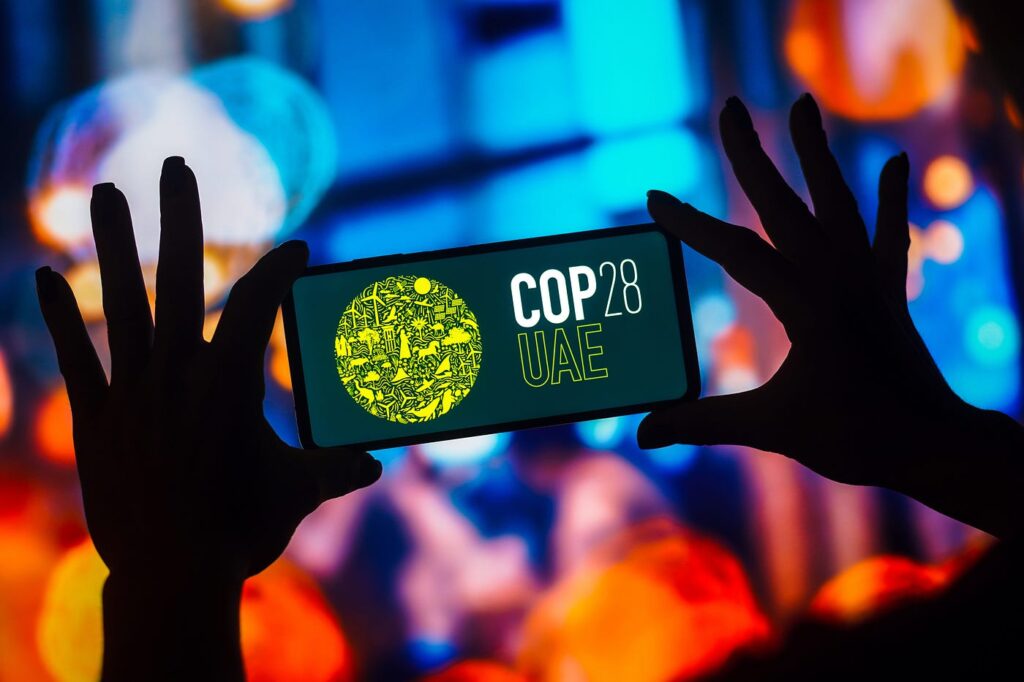

The COP28 Climate Change conference in Dubai is rapidly approaching and already making headlines. The media buzz is especially focused on the energy sector, who will now have a seat at the UN negotiating table.
Energy companies have opportunities to proactively shape their media reputation ahead of the conference. But that attention may bring new challenges and risks. So it’s important for energy communicators to be prepared for potential criticisms they may face.
To surface these risks, PublicRelay examined the media landscape for energy companies ahead of COP28. We drew on a sample of top stories in September and October 2023 about the conference.
Here are five PR risks energy communicators must prepare for ahead of COP28:
1. Watch out for concerns about competing interests
Climate advocates are skeptical of oil & gas’s involvement in COP28. Al Gore recently slammed the conference’s appointment of Sultan al-Jaber, the CEO of the Abu Dhabi National Oil Company, as COP28 president.
Wider oil & gas involvement may fuel fears that the sector is attempting to capture and obstruct global climate progress. That was the most prevalent and wide-reaching concern in the media. Some activists went so far as to demand boycotts of the conference.
2. Anticipate scrutiny about the scope of climate pledges
Companies like Shell and TotalEnergies have rallied around a Global Decarbonization Alliance in the oil & gas sector. Championed by the COP28 president, this alliance commits reducing emissions from oil extraction. It also aims to reduce methane emissions and oil leaks.
Energy companies should expect criticism about the scope of those commitments. Critics highlight that they miss scope 2 and 3 emissions where the energy sector’s impact is greatest.
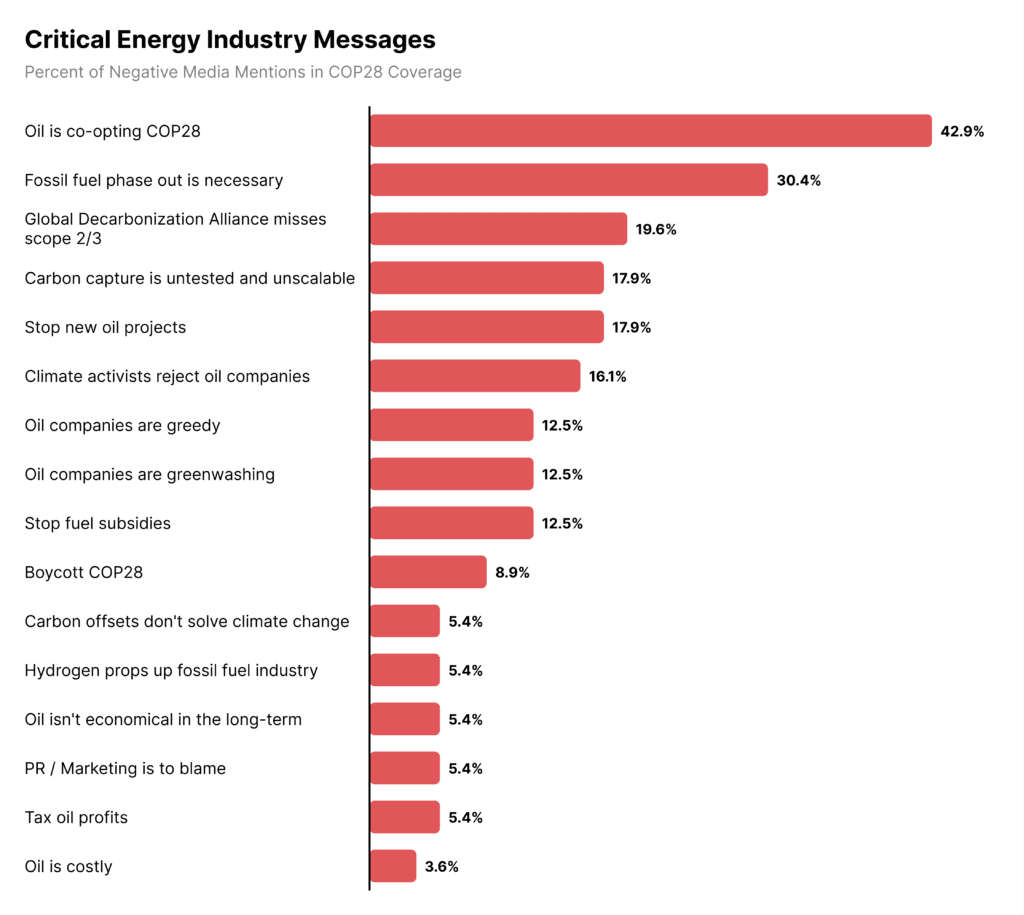

3. Be ready to defend future energy solutions
Climate advocates will likely be skeptical of new investments in new energy solutions. These range from carbon capture technologies to development of hydrogen fuel.
Some claim that carbon capture approaches are untested and unscalable. Some call out hydrogen development as simply re-entrenching reliance on fossil fuel.
4. Expect demands for financial commitments
Climate finance will be among the leading topics at COP28. Climate leaders are hoping to mobilize capital toward new climate-friendly infrastructure.
But some policymakers are also calling for prices on carbon, windfall taxes on energy profits, and a rollback of fuel subsidies worldwide. Energy companies may even be expected to arrive at COP28 with innovative approaches to carbon credits and pricing.
5. Manage perceptions from climate academics
Environmental activists are the biggest critics of energy companies. They speak loud and often.
Yet climate academics may be a bigger PR risk. They don’t criticize energy companies regularly. But when they do they receive higher engagement on average. Academics may be seen as more objective and credible to a wider audience.
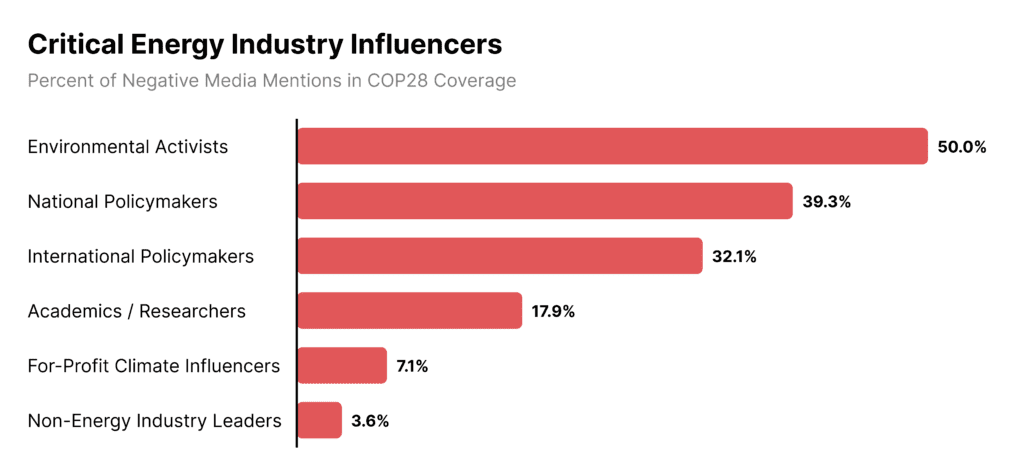

PR is in the spotlight
The stakes are high for energy communicators. Climate leaders will watch energy companies closely. Climate advocates may be quick to label the energy sector’s involvement in COP28 as nothing more than a greenwashing stunt.
Energy communicators must emphasize their genuine commitment to climate solutions. Make clear that oil & gas pledges may just be a first step in a larger green transition. Be prepared to showcase tangible investments in new and viable energy solutions. Offer support to innovative financing arrangements to position yourself as a forward-looking business.
Platforming third-party support is also necessary. Engage credible experts that can objectively support the energy sector’s efforts. Play up support from climate leaders like US climate envoy John Kerry and the Environmental Defense Fund’s Amanda Leland. Those influencers may be more hopeful that energy’s presence at COP28 can move climate progress forward.
Related Resources


This year’s COP28 Climate Change Conference in Dubai is going to make headlines. Unlike prior years, global energy companies will have a seat at the negotiating table. With no less than the future of UN climate change policy up for debate, the stakes are high for energy communicators.
The energy sector’s involvement at the conference presents reputational challenges and opportunities. So it’s crucial for energy communicators to proactively shape their media reputation.
PublicRelay sought to understand the media landscape for energy companies ahead of COP28. We analyzed a sample of top stories in September and October 2023 about the conference. We also focused on the media’s coverage of major energy companies around COP28.
Here are five PR strategies for energy communicators ahead of COP28:
1. Seize the Spotlight on Energy Solutions
The COP28 news cycle will undoubtedly revolve around energy solutions. Energy-focused articles were most prevalent and mostly positive. They also had among the highest reach and social engagement.
Emphasize your company’s innovations in new energy areas. Positive energy stories focused on the development of renewables like solar and wind. They also discussed the growth of new technologies like carbon capture and hydrogen.
2. Embrace Climate Finance
While energy solutions led the media conversation, climate finance generated just as much social engagement.
Position your company as a leader in financing the transition to a greener future. Highlight investments in new energy solutions. Play up support for innovative approaches to carbon credits and taxation. This will reinforce your image as a forward-thinking business.
3. Capitalize on the Intersection of Climate and Global Health
Global health is an emerging topic in the climate conversation. It didn’t appear often in the COP28 news cycle, but coverage was entirely positive and widely amplified.
Showcase your contributions to global health through environmentally sustainable practices and products. This approach will likely be well received. It may also garner high syndication and sharing.
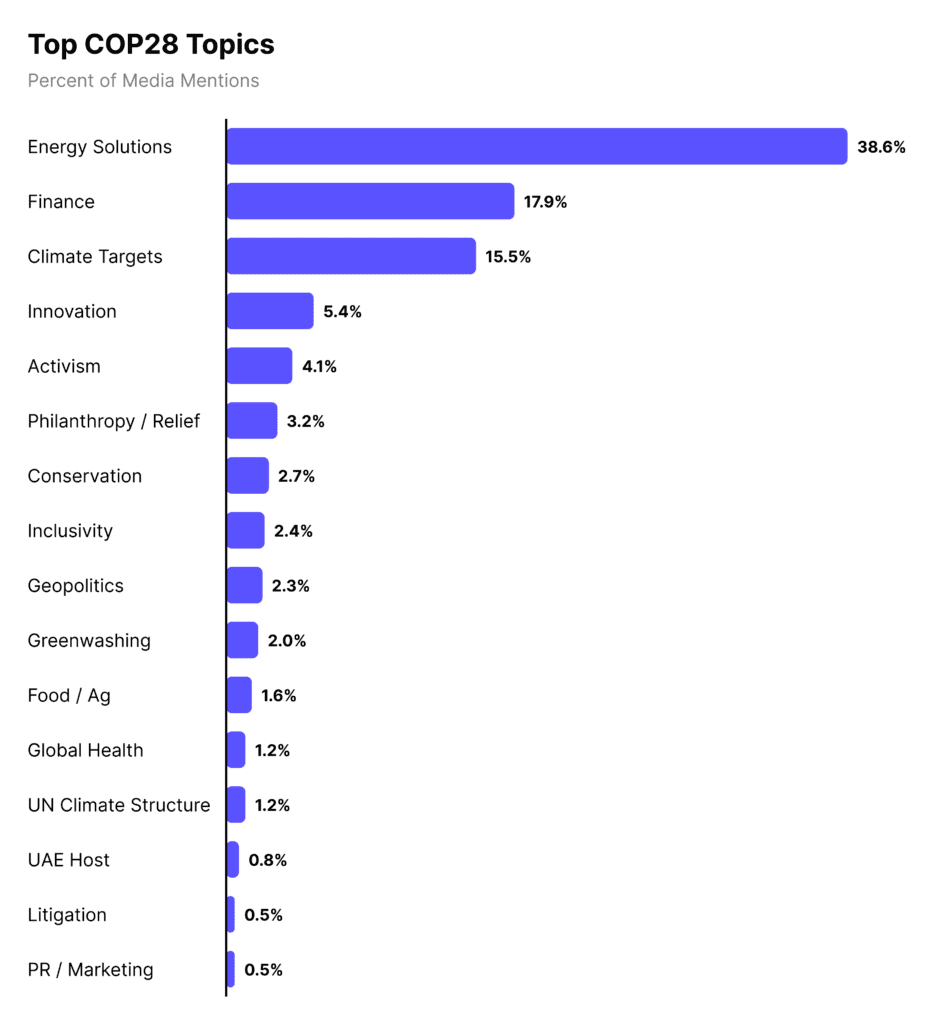

4. Support Oil & Gas’s Climate Commitments
Oil companies involved in COP28 have an opportunity to take on a greater role in climate action. Early media signals of the oil & gas sector’s climate commitments were positive.
Third-party climate influencers called for energy companies to lead on climate change. Some were optimistic about initiatives like the Global Decarbonization Alliance championed by COP28 president Sultan al-Jaber.
5. Frame your Climate Action as a Transition
Position energy decarbonization as a crucial first step in a just energy transition. Global demand for energy is increasing. But tangible actions by the energy sector can help mitigate the effect of emissions.
Sector-wide initiatives that were viewed positively included reducing methane from oil extraction. Preventing oil flares and leaks also had positive pick-up. These messages may resonate with the public. They can reinforce the sector’s role in meeting global energy demand responsibly.
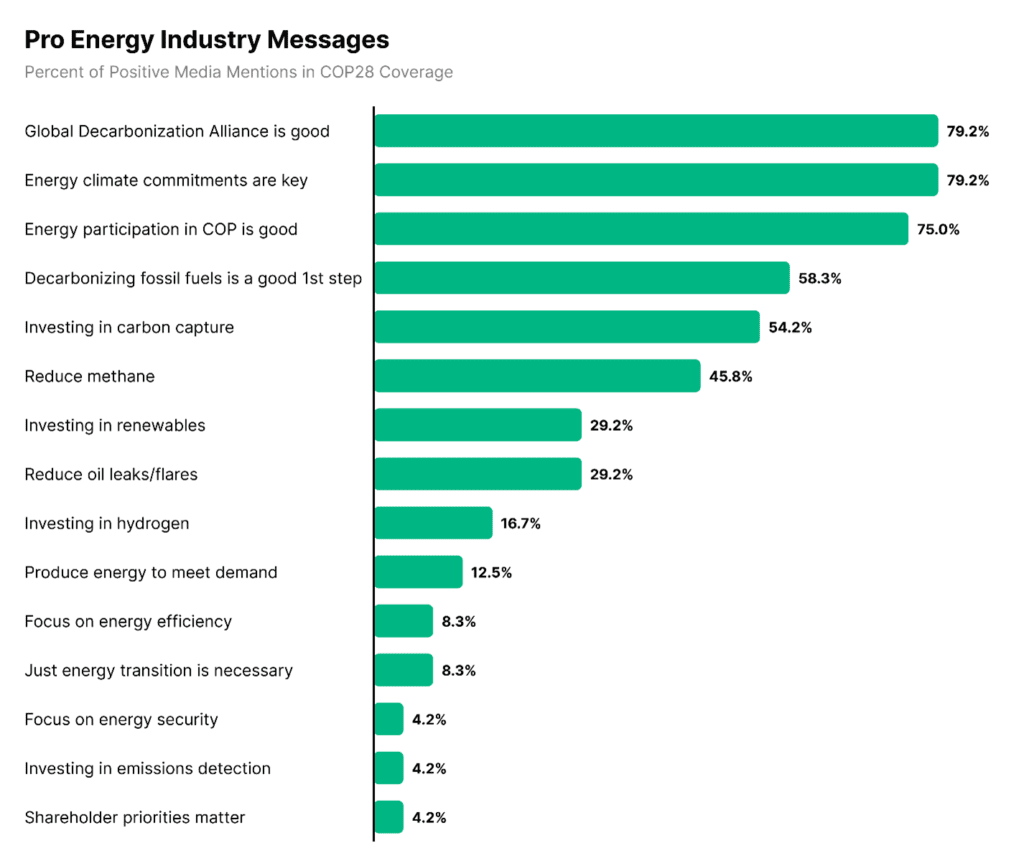

Managing Risks
Remember that addressing media scrutiny is important. Communicators should prepare to transparently respond to criticism at COP28. Expect accusations of energy companies co-opting global climate negotiations. Have a strategy to manage potential activist calls for boycotts of the conference.
Furthermore, acknowledge the scope of your emission reductions strategy. That’s especially when it comes to scope 2 and 3 emissions. Be ready to engage with politicians’ calls for taxes on energy profits. Highlight your commitments to invest in clean energy innovation worldwide.
COP28 is an opportunity for energy companies to reposition themselves as leaders in the global transition to a sustainable energy future.
Energy communicators must capitalize on emerging positive narratives and address challenges head-on. This can help their companies shine at COP28 and beyond.
Related Resources


Employer brand – your company’s reputation as a place to work – goes beyond impacting recruitment efforts. It’s an essential facet of your overall corporate reputation and can even influence consumers’ purchasing decisions.
You may think a satisfied workforce translates into a strong workplace reputation, but employee experience and employer brand aren’t always aligned. And that disconnect can come down to your communications.
However, employee brand ambassadors can help bridge the gap.
Engaging your employees as brand ambassadors can be one of the most powerful methods for improving public perceptions of your company’s workplace culture and managing your reputation.
What is an Employee Brand Ambassador?
A brand ambassador is an employee who promotes a company’s employer brand to their personal networks, usually via social media. As a prerequisite, they often have substantial social followings and online conduct that aligns with the brand’s values.
Traditionally, brand ambassadors were “influencers” – usually celebrities or individuals with significant name recognition – unaffiliated with the company they were paid to endorse (think Kiera Knightley and Chanel).
But rather than using prominent figures as they do for product endorsements, companies often turn to employees to advocate on behalf of their workplace culture.
Why Recruit Employees as Advocates?
Communications teams should recruit employees as advocates because audiences view employees as authentic and trustworthy sources of insight into their company’s mission, values, and ethics.
Stephanie Genin, Global Vice President of Enterprise Marketing at Hootsuite, explains that “brands are seeing value in influencer marketing because consumers are more influenced by an authentic, human communication than by corporate jargon.”
Not only does the public have more trust in perceived “normal” people, but the 2019 Edelman Trust Barometer found that 53% of all global audiences view employees as the most credible source of information when forming an opinion of a company. Another 78% agreed that “how a company treats its employees is one of the best indicators of its level of trustworthiness.”
In other words, employees are one of your most valuable resources for managing your workplace reputation.
Create an Employee Brand Ambassador Program
Consider engaging employees as brand ambassadors an element of your internal communications strategy.
And by launching an employee brand ambassador program, you can more effectively mobilize employee advocates to deliver the key messages that support your communications objectives.
Here are three ways to build a program optimized for impact:
Assess Your Employer Brand
Implementing an employee brand ambassador program is an opportunity to evaluate and understand your existing employer brand.
You must assess two aspects of your employer brand: employee experience and workplace reputation.
Employee Experience
Research your company’s employee experience on employee review sites like Glassdoor and social media platforms. For real-time feedback and suggestions for improvement, you can hold focus groups or conduct an employee feedback survey to assess your existing workplace culture.
Suppose it becomes evident your employees are unsatisfied with your company as an employer. This may be the place to start – by fostering a positive workplace environment and recognizing employee achievements – before recruiting ambassadors.
Alternatively, if your research indicates your company has successfully established a positive workplace culture, you can utilize this data to pinpoint your company’s strengths and identify themes for your ambassadors to highlight.
Workplace Reputation
To evaluate your external workplace reputation, you can use reputation polls or corporate reputation rankings to gain insight into public perceptions of your company as a place to work.
You can also use media analytics for a nuanced understanding of how the media covers your brand on various workplace reputational drivers that shape public opinions of your company culture.
Analyzing the data on your company’s workplace reputation against its employee experience will reveal any misalignment between the two and the workplace topics that could benefit most from your employee endorsements.
Recruit Volunteers
The value of employee endorsements resides in their personal experiences with the company and their willingness to advocate on behalf of the brand. Accordingly, enlisting brand ambassadors on a volunteer basis is crucial to the authenticity at the crux of their support.
Not only do audiences view employees as more trustworthy sources of information on a brand, but an authentic employee endorsement of your company as a workplace is one of the most impactful methods of verifying and reinforcing your desired employer reputation.
Encourage Ownership
Ramp up your internal communications and provide your team with frequent updates on company news and employee achievements, along with tools to simplify social sharing.
Encourage employees to take ownership of personal and company accomplishments by highlighting their role in successes and output. When employees are invested in their work and recognized for their performance, they will be more inclined to share positive company news with their social networks.
Take Control of Your Workplace Reputation
Engaging your employees as a part of your communications strategy will make your workplace messages more credible and ultimately improve public perceptions of your company culture.
At PublicRelay, we measure your workplace reputation as it’s represented in media coverage and on employee review sites, including Glassdoor and Indeed. With this insight, you can better understand your current reputation and benchmark your performance and the impact of your employee ambassador program in influencing your public perceptions of your brand. Start improving your workplace reputation now!
Related Resources


Once the public relations landscape is understood and your communications objectives are specified, the strategy development process begins. Of fundamental importance, stakeholder segmentation and media prioritization set the stage for strategy development (for both internal and external audiences). Once one understands the audience and the media to which they read, watch, and listen, the next step is to determine the messages to deliver.
Message engineering research helps pinpoint which messages perform best in terms of being compelling to the audience and credible coming from your organization. The result is stakeholder-centric communication that lays the groundwork for purposeful strategy and the tactics that bring the strategy to life. Unlike tactics, strategies remain in place over time and must support a variety of tactical bursts of activity to drive results. As such, research helps to inform the messaging and targeting approaches that are most likely to survive short-term market shifts to deliver positive and sustainable results.
Prioritizing Stakeholders and Targeting Media
Assumptions, intuition, and experience are not enough to make strategic decisions. Research, analysis, and evaluation must be conducted about stakeholders, including the media, to truly understand who they are and what messages will resonate.
It is vital to place significant focus on foundational research to discover which media perform best in terms of target stakeholder reach and penetration. To clarify, “reach” equals “circulation and audience.” “Penetration” means the “percentage of target stakeholders reached through an individual media outlet.” The media targeting process should involve some form of foundational research, which may include the following:
- Demographic/firmographic data available directly through attribution technology or indirectly through third-party data providers of media demographics.
- A survey to uncover the stakeholder’s awareness, attitudes, and behavior toward an individual medium as well as their media consumption preferences. These stakeholder attributes are further validated through a content analysis of news and social media.
- Social media analysis to profile stakeholders by their comments, how they self-identify, and the content they hyperlink through social sharing.
In addition to identifying the media with the highest potential, strategy research also reveals the relative authority and receptivity of journalists and influencers whose content appears in the media (traditional and social).
Using Media Analysis to Inform Your Communications Strategy
Professional communicators must find a balance among the media to identify just those which are:
- Important and engaging to the target stakeholder
- Most likely to cover news about your organization
- Least likely to cover competitors’ news
While an analysis of demographics and firmographics will tell which sources deliver the highest penetration among actual and potential customers, it will not indicate which media are more likely or less likely to cover a particular theme. However, a media analysis will tell which media are more receptive to the themes that matter most to you and your stakeholders. With this, content analysts can quantify the presence of intended and unintended messages, capture any reporting tendencies, and reveal a roadmap toward better results. This combination (the demographic audit and the media analysis) will reveal which media are considered the most credible, which match the often-subtle interests of the stakeholder, and which compel the highest levels of engagement among the targeted stakeholders. Combining media demographics and surveys with media analysis creates a basis for action and a foundation for success.
Message Engineering
Positioning or messaging is not a purely creative endeavor; research-based “message engineering” is an example of how science and creativity come together to result in more effective public relations. The science behind public relations enhances the creative process and helps illuminate the most compelling and credible messages. Message engineering is a data-informed stakeholder-driven process of developing a brand, an issue, or corporate positioning. When developing an optimal messaging strategy, research helps the communicator to:
- Understand what motivates the target to act
- Determine the degree to which the proposition can be made credibly by the organization and match the target stakeholder’s priorities and reality
- Evaluate how the competition or opposition performs against the same criteria
- Consider aspects of the messaging that hold the potential to be misinterpreted, hijacked, or somehow otherwise detrimental from certain perspectives
When one combines message engineering with media optimization, one reaches the intended audience in the best possible way.
Why Develop a Data-Driven Communications Strategy?
There are six reasons for establishing data-driven strategies:
- The data-based strategy development process enables more efficient tactical planning and execution.
- By putting stakeholders first, the strategy focuses resources on the objective rather than conventional wisdom, pure creativity, or vanity.
- It mitigates risk by pre-testing strategy before execution.
- It allows for a sustainable strategy.
- It provides a common language to gain alignment in advance among executives who sponsor or evaluate corporate communications performance.
- It creates alignment with peers across the enterprise and within the function, enabling the communications department to prosper.
Communications Strategy Development Methods
Methods of developing data-driven communications strategies include:
- Quantitative research (surveys) and qualitative research (focus groups) to uncover insights about the media consumption preferences of stakeholders and the messages most likely to resonate.
- Analysis of news outlets’ published articles and social media channels to determine what topics they cover and how they cover them.
- Media demographic audit to determine which media deliver the highest penetration among actual and potential customers, employees, and other targets.
- Social listening – in the form of a digital focus group or media analysis — to uncover insight into stakeholder interests, preferences, and behavior.
- Analysis of journalists and influencers to identify target intermediaries to deliver key messages to key audiences.
- Competitor analysis to gauge which strategies appear to be most effective among shared stakeholders.
- PR attribution analysis to identify which digital media and messages are most likely to drive click-through to the website and to track how people engage with the site (e.g., the pages they visit and the information they download).
Example: How a Data-Driven Communications Strategy Leads to the Right Messaging
A company is set to launch a new product to drive revenue for the company’s second-half financials. Thanks to the communications team’s social listening tools and traditional media analysis, the team can see security concerns are being raised around topics related to their new product. These insights are considered and alter how the product is communicated before launch, and a security focus is dialed up as part of the product benefits. Ahead-of-launch messaging is updated, and product benefits are re-ranked to highlight security. The communications team can report its role as part of the business outcome through predictive listening.
# # #
Mark Weiner is the Chief Insights Officer for PublicRelay and the author of “PR Technology, Data and Insights: Igniting a Positive Return on Your Communications Investment.”
Excerpt from “The Communicator’s Guide to Research, Analysis, and Evaluation,” originally published by the Institute for Public Relations in March 2021.
Editor’s Note: Interested in learning how you can demonstrate the value of your work? Read our guide to PR attribution!
Related Resources


In every business case, there is an objective: it might include generating a profit, attracting and retaining top talent, or giving back to a community. In every case, the goal is to build and reinforce relationships, reputation, and organizational performance. To advance an organization, professional communicators must clearly understand its aims to help the organization achieve its business objectives. While each component of the research-based public relations continuum is integral to achieving positive results, the initial stage of objectives-setting research is the most important. Yet, it is also the most frequently overlooked. Setting objectives is the foundation for the entire public relations program on which strategy, execution, and evaluation are formed. Setting and then exceeding objectives that are meaningful, reasonable, and measurable support the communicator’s ability to demonstrate the value of public relations and provide forward-looking insights.
Writing Meaningful, Reasonable, and Measurable Objectives
The difference between a goal and an objective is that goals are relatively vague but represent an overall outcome the public relations professional wants to achieve. They should align with the business goals and reflect the broad aspirations of the organization and often appear in the form of “vision statements” and “statements of purpose.” On the other hand, objectives are measurable and focused, serving as a guide and allowing professionals and others to see how and when they have been met or exceeded. To elevate public relations, one must generate and demonstrate a positive return. While demonstrating the value of public relations is among the profession’s most vexing challenges, the best path is also the most direct: work with executives who control the budget and evaluate performance to set objectives that are meaningful, reasonable, and measurable.
Therefore:
- Meaningful objectives align with organizational goals and the priorities and preferences of executives in charge of evaluating and/or funding public relations.
- Reasonable objectives are openly negotiated with the executives who evaluate and fund public relations programs and confirm what the public relations function can realistically be expected to deliver.
- Measurable objectives ensure that communications performance can be easily quantified regardless of whether the person evaluating performance understands public relations or not. Measurable objectives specify:
- What should be achieved (e.g., “to increase awareness of our socially responsible investment funds”)
- The target stakeholder (e.g., “female millennials”)
- The time frame (e.g., “from June to August”)
- The desired measurable change (e.g., “raise awareness by 7%”)
Objectives should follow the SMART (specific, measurable, attainable, relevant, and time-bound) format, which allows for the creation of strategies and tactics that clearly align with each objective and the ability to later demonstrate a return on expectations.
Unlike indeterminate objectives like “generate buzz,” “break through the media clutter,” and so on, the objective is specific and clear, such as: “to increase awareness of our socially responsible investment funds by 7% among female millennials from June to August.”
Why Set Objectives?
Research takes the emotion out of objective setting. There are six reasons for setting clear, concise, and pre-negotiated public relations objectives:
- Create a structure for prioritizing action among members of the communications team.
- Allow the team to stay focused and circle back to the objectives to ensure the strategies and tactics support achieving (and hopefully exceeding) the objective.
- Reduce the potential for disputes before, during, and after the program.
- Increase efficiency by concentrating resources where they will make a difference, thereby reducing waste.
- Help to form successful programs by focusing attention and action on those criteria by which the program will later be evaluated.
- Set the stage for evaluation by enabling public relations investment decision-makers to determine if the public relations program delivered on its promise.
Objective-Setting Research Methodologies
Research methods to inform objectives may include:
- Data or information gathered from conducting a public relations landscape analysis (i.e., market research, traditional media analysis, social media analysis, web analytics, and digital media attribution) to inform objective setting.
- Primary research (research conducted by the organization, such as surveys or focus groups with internal or external stakeholders) or secondary research (research that has already been conducted by the organization or another entity) that validates the problem or opportunity the objective seeks to address.
- Internal research to ensure that PR objectives align with overall organizational goals as determined through a review of the enterprise’s mission statement and publicly stated priorities.
- Leveraging prior company data as a baseline that objectives will be measured against.
Defining Metrics and Key Performance Indicators
When setting objectives, it is important to define metrics and indicators that communicate success.
For instance, the example objective above seeks to “raise awareness of our socially responsible investment funds.” To one person, raising awareness might mean securing media placements about the investment funds. To another, it might mean surveying the intended target stakeholder (female millennials) to gauge if they are aware of the investment funds. Having a clear definition of the desired key performance indicators and how they will be measured helps to determine later the success of your efforts to meet or beat the objectives. Regardless, the metrics should be valid, meaning that they must actually measure what they are supposed to measure. For example, some may use impressions to measure awareness, which is not a valid metric for measuring awareness.
Differentiating Between Outputs, Outtakes, and Outcomes
When writing measurable objectives, it is important to recognize the difference between measuring outputs, outtakes, and outcomes. Ultimately, all are reflected in your objectives since they are interrelated.
Outputs
The number of communications deliverables the organization produces by using and resulting from a communications process; the number distributed and/or the number reaching a targeted stakeholder.
Example of an Output
How many internal messages did the organization send on a particular issue?
Outputs are a measure of production and distribution. They are focused more on what the organization does rather than how the program affects the attitude or behavior of the intended audience. Other important metrics include outtakes and outcomes, especially behavioral measures as communicators ultimately seek to ignite behavioral change.
Example Metrics Used to Measure Outputs
- Number of tactics, events, and materials produced, sent, or distributed (i.e., newsletters, brochures)
- Traditional and social media coverage, Share of voice Circulation/audience/reach
- Mentions
- Tone of coverage, intended and unintended message pull-through
Outtakes
Measurement and analysis of how stakeholders respond to programs, initiatives, campaigns, and content are foundational for optimizing and highlighting the value of public relations investments. Although many communications KPIs are more perceptual in nature (e.g., brand, reputation), outtakes are a key underpinning as they are clear and tangible (e.g., view, open, read, share, download, etc.). In this way, “outtakes” may be considered “short-term outcomes.” What did they take away from the communications program?
Example of an Outtake
The degree to which a stakeholder “received the message” is measured in terms of awareness, recall, understanding, and retention.
Example Metrics Used to Measure Outtakes
- Followers/subscribers
- Click-throughs
- Likes and retweets
- Engagement (i.e., comments, shares)
- Recall, awareness, understanding, and retention
- Web analytics (i.e., unique visitors, bounce rate, downloads, click-throughs)
- Open rate ratings/testimonials
- Viewership/readership
Outcomes
This is the ultimate goal and related KPIs to which leading senior communicators aspire. Outcomes are more macro and often more perceptual in nature. These often include a quantifiable change in awareness, knowledge, attitude, opinion, brand/reputation equity, and/or behavior levels that occur as a result of public relations programs, initiatives, or campaigns. Outcomes result in an effect, consequence, or impact of a set or program of communications activities or products and may be either short-term – even immediate – or long-term.
Example of an Outcome
Outcomes represent what’s on the minds of stakeholders, including awareness, preference, and purchase intention, for example.
Organizations should also think about the impact of a program on business outcomes, such as: How did the PR program affect people’s attitudes toward the company or its product because of public relations actions taken or tactics deployed? To what degree did PR contribute to attracting and retaining talent? How did PR improve the organization’s ESG investment rating?
Example Metrics Used to Measure Outcomes
- Awareness
- Knowledge/understanding
- Attitudes/opinions
- Reputation
- Trust
- Transparency
- Attendance/product/service
- Consideration
- Products/service preference
- Customer purchase/acquisition and retention
- Employee acquisition and retention
- Satisfaction
- Loyalty
- Advocacy (e.g., Net Promoter Score (NPS))
- Brand equity
- Brand valuation
- Behavior/sales
- Other behavioral changes (e.g., donate, vote, partner, policy change)
# # #
Mark Weiner is the Chief Insights Officer for PublicRelay and the author of “PR Technology, Data and Insights: Igniting a Positive Return on Your Communications Investment.”
Excerpt from “The Communicator’s Guide to Research, Analysis, and Evaluation,” originally published by the IPR in March 2021.
Editor’s Note: Interested in learning how you can demonstrate the value of your work? Read our guide to PR attribution!



